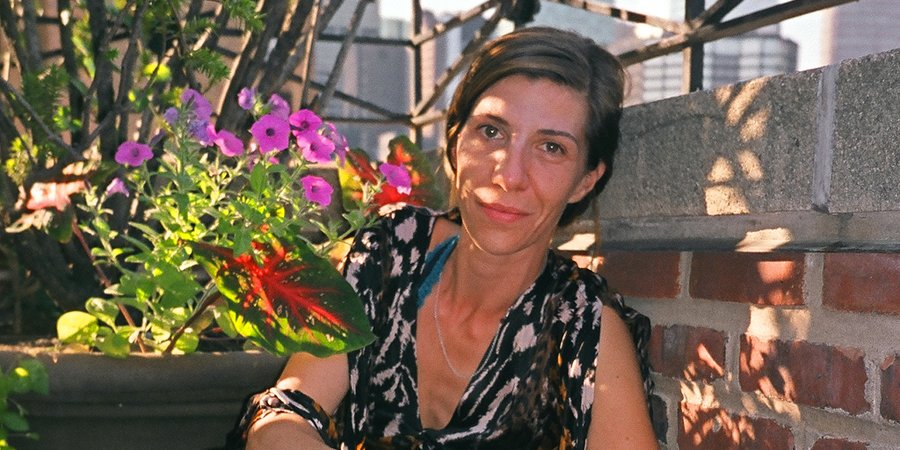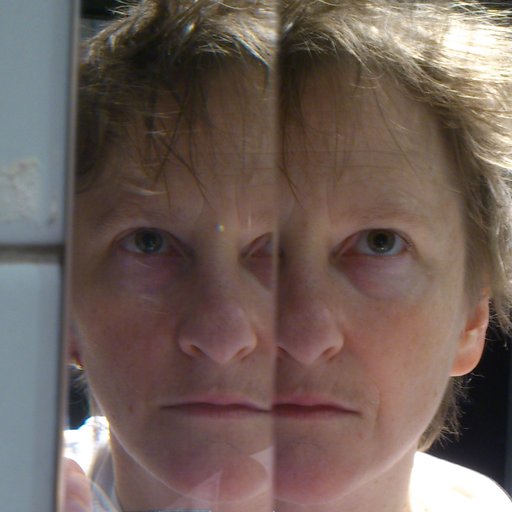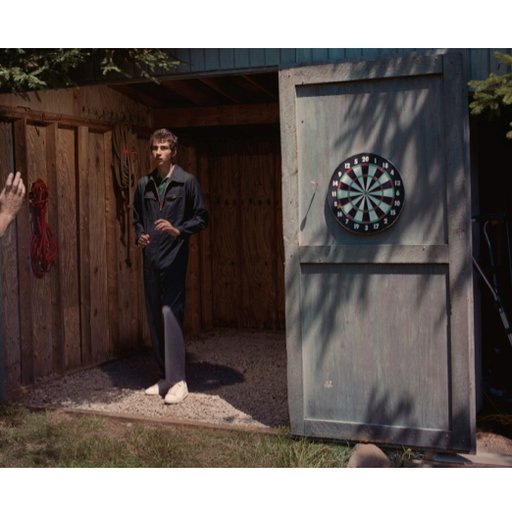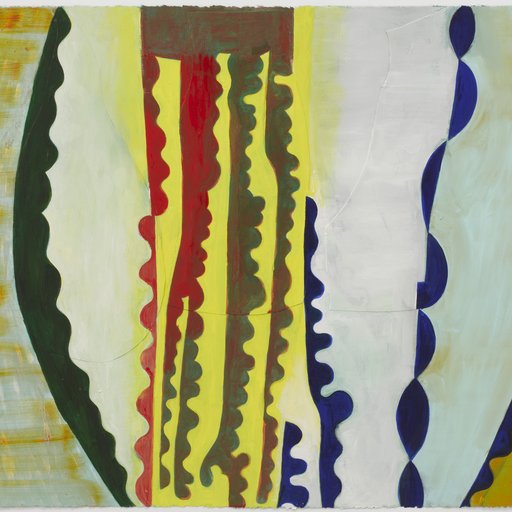The artist Agathe Snow came of age as a core member of the rough-and-tumble 1990s New York scene that gave us Ryan McGinley , Dan Colen , and her late ex-husband Dash Snow. Her artworks—which leapt exuberantly from music and food to paper and pencil—contributed a warm sense of hands-on anarchy to the proceedings. Taking the form of dance marathons and impromptu dinner parties (which she often organized with her sister, Anne Apparu, and the artist Marianne Vitale ) as well as ebullient trash sculptures and collages, Snow's work harnessed the pleasures of friendship, community, and simple fun. While much in her life has changed, these themes continue to animate her art today.
This summer, Snow’s festivities are being presented in an unusually rarefied setting: the Guggenheim , which is playing host to a 24-hour film screening and party from August 20 to 21. The film documents an earlier day-long celebration, planned and filmed by Snow and her co-conspirators in 2005; footage from the event was recently compiled and edited, after being locked away for a decade.
Snow, who is represented by the Los Angeles gallery OHWOW , has come a long way since her wild-child days; she's more reflective, if still a free-spirit. Artspace sat with the artist on the steps of the Sara D. Roosevelt Park—just blocks from her old haunts—to discuss the benefits of getting older, the surprising impact of 9/11 on her career, and the enduring power of the creative community in New York.
When did you first move to New York?
In 1987. I moved here when I was between 10 and 11 with my mom and my sister and brother. My mom had a restaurant in Corsica, but it was only open five months out of the year so the rest of the year she didn’t know what to do. We came here, just to go to school, and after two years she opened a bakery on Prince and Elizabeth. After that I went to college, and then I came back on my own in ’97.
You’ve said that it took you a while to start thinking of yourself as an artist, in part because you never went to art school. How did you eventually come to the realization that you could in fact make art yourself?
I was told I could make art. I’ve always made things, so I was making all sorts of little things all the time. My friends went to art school, and I was married to Dash at the time. We didn’t know what we were going to do—I was working at my mom’s restaurant. After 9/11 she closed it down because there were no more people. It was all closed off down here.
After that, Dash and I were like, “Oh my god. What are we going to do?” I was working a bit in fashion and acting, and I was still making all my things. My friend Dan Colen came back from art school as said, “Well, you guys are artists. You make art—Dash with his Polaroid and you with your weird little things.” Dash took it seriously, but I was like, “This is crazy.” Coming from Europe, being an artist or being in a museum means you’re dead. You have to have done so many things to be called an artist. It was so unreachable a goal, so I was kind of confused about that title.
I made more and more things, and I was recognized more and more by people who said, “This is art.” I started to study art more, but it took me a lot of years of making things and doing things until I said, “OK, I’m ready. I can be an artist.”
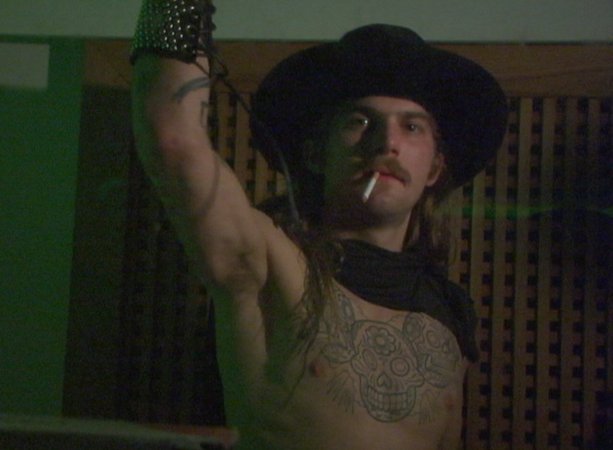 Still from
Stamina
, 2015. Image © Agathe Snow.
Still from
Stamina
, 2015. Image © Agathe Snow.
Was Dan Colen's giving Dash the label of “artist” a revelation for him as well as youself at that time?
Yeah. Dash was really lost. For my part, I was doing all kinds of stuff, but he was just like, “What am I going to do with my life?” He stopped school when he 14 or 15, and I had gone to college, at least, so I had some options. Dan kind of took Dash under his wing. They went to Art Basel, and when they came back they were artists !
I used to do my dance marathons, as well as this thing called "Feed the Troops," where I set up tables all over the city three times a week to feed people. That was written up in Artforum as an art project. I was afraid of making things that would last. I would set up the dinners, set up the dance marathons, do videos—but making things that last, that you can sell? I was terrified. Eventually I started picking up stuff off the street and making things, but it took me a really long time. By the time I did my first show at James Fuentes, I was ready.
What kind of work went into pulling off your dinner parties? Were you thinking about these events within any kind of artistic or political framework?
It was always about the community, getting people together in weird environments. I had different series—every Friday was something on a stoop or steps, or else someone’s hallway. It was kind of an invasion, taking over a space. I wasn’t an artist, but I knew I had to be in peoples’ consciousness so I would basically do things anywhere with anyone. I would do collaborations with different people on one dinner. We’d set up big tables, a whole environment, so it became more theatrical. I grew up doing lots of theater things, so I love that aspect of it, the setup of the scenes and the situations. If a certain dinner was about the war I’d serve all Iraqi food, for example. It became more and more conceptual.
New York itself has that constant movement that I saw in the dance marathons, so the dinners were those moments when you sat down and chill. Wherever you are, whether it's on the Staten Island Ferry or some stoop, everyone sits down together and talks. That was the idea.
This outlook reminds me of the very early “proto-raves” of the 1970s, like the parties in David Mancuso’s apartments. His projects also incorporated food and dance, building alternative groups within the city. It’s a community-based approach to partying.
Extremely so, and, like his work, my projects formed families. No matter what you do all week long, you know on Sunday afternoon you could go there. There are so many people in New York that you can make a best friend in one day and never see them again. That feeling of community, forming something that matters... you’re so much stronger together. Even though we all ended up being artists, for a while we were just a bunch of friends. It was really important to us as a kind of energy-making project. It was about being together, making noise, and making sparks.
Then 9/11 happened. That was an insane time, because everyone in the world wanted to know what was going on below 14 th Street. And we were all there, you know? We were a bunch of people, a big group, and all the magazines started asking us questions about what we were doing, so no matter what we did it felt like it was important. It gave you a big ego boost.
 Still from
Stamina
, 2015. © Agathe Snow.
Still from
Stamina
, 2015. © Agathe Snow.
In a way, it seems like 9/11 actually jump-started your careers.
Pretty much.
Were you aware of this at the time?
We weren’t thinking about it, but it’s funny—14 years later, I feel that it was something that happened to the world, not to New York. At the time, though, it felt so much like something that was happening to New York City, to us. It was life-changing—I knew that much at the time. Now I see the impact it had on the world as well. Maybe it was youth, maybe it was something else, but at the time what mattered was those 14 blocks and that group of people, what we did and how we did it. There was lots of love, lots of ideas being passed around. Lots of energy, basically.
What would you say was the biggest shift in your work post-9/11?
Attention. All of a sudden people are looking at you, so what do you do? Do you keep doing what you’re doing? Do you go crazy? Our feeling was that we had no idea what was happening next, so we might as well take advantage of the situation. The idea was “let’s just go for it,” so we went louder and bigger. That was the big change—all of a sudden there would be attention no matter what we did, but at the same time we didn't know what was going to happen in a year, in a day, even. It was just “go for it.” It was scary at times, but at the same time it was so liberating. It was an amazing moment.
Your upcoming exhibition at the Guggenheim will showcase the never-before-seen footage from one of your 2005 marathon parties, which you held in a space on Ann Street right next to Ground Zero. Do you see this event as being a part of this post-9/11 enthusiasm and risk-taking?
For two years after 9/11 we were really partying and going crazy, as if there was no tomorrow. Then we all got professional. With all the attention, we started being artists. We started to separate—it was not so much about the group any more, it was about the individuals. That event in 2005 was already nostalgic, trying to memorialize this moment that happened after 9/11 in New York City to this group of people, and it was kind of a last hurrah for us.
It was like a family reunion, in a way.
Exactly. We were still going out every night, but the thought was that if we don’t memorialize this now, we’re never going to do it again. Everyone was getting very serious and professional, going to art fairs and opening shows and heading in different directions.
There was a feeling of nostalgia, but I think we also reproduced that feeling that was going on after 9/11. Ann Street had not been fixed yet, so it was still as if you were there. There were no cars, the street was gutted, we were in this squat, so you really got that feeling of that moment right after it happened.
When planning for this party, did you know that you were going to be holding onto this footage for almost a decade?
No. It was supposed to be a trial for something bigger, like a TV show. It was the beginning of reality TV, before there was any dance show on TV, so the idea was a Gangs of New York , West Side Story kind of thing, with people fight-dancing each other. The 24-hour party was supposed to be a trial, to test it out and say, “Look what we can do.” It was like a pilot episode.
There was a script, so when you watch it it’s really funny. There are moments where it makes no sense—at the beginning of the night there were all these scripts with people playing different characters, kind of to get people in the groove. Eventually everything was let go and it was just a big, wild party. There was a bar mitzvah, there were so many things that make absolutely no sense, but they were part of the setup of the script that was abandoned around 5 a.m.
 Still from
Stamina
, 2015. Image © Agathe Snow
Still from
Stamina
, 2015. Image © Agathe Snow
So this isn’t just documentation of a free-flowing party?
No, there was some structure to it, until we got to the place where everyone was loose. I remember what it was like—we just let go and saw what happened. But then, you know, by 1 p.m. in the afternoon everyone was tired and wanting to go home, so you also see downtime.
Watching the film, you really get the sense of there being so many different people. Even though the idea was to show us as one big group, everyone got their five minutes in there. You really see portraits of all these different people. It’s wonderful, beautiful.
What can you tell me about the filming and editing process?
We thought that we would do a really fast edit and show it at Art Basel in a space [Jeffrey] Deitch had rented. The idea was that it would be the premiere of the pilot to get money for a bigger project. It didn’t turn out like this at all, because we ended up with 24 hours times 9 cameras of footage. We thought we’d be able to look at the footage while we were filming the thing and kind of have a sense of what we were working with, but when you have 15 different camerapeople that are not really camerapeople, when everything is marked wrong, when a camera gets stolen—there were so many different elements that just went crazy.
There were two people I had worked with in the production department that would be working on the editing who got together and left for California. They had babies and just left New York City. I ended up with all these tapes in the end. At the same time, a lot of people in the film fell out of the picture. A lot of people died. In the movie right now, five of my closest friends are dead. I was like, “I can’t deal with this footage.” At that point I decided to put it in a safe and not take it out for 10 years.
I didn’t really think I was going to do anything with it, but the Guggenheim said, “Okay! It’s 10 years—gotta get it out of storage and do something with it!” So that’s what I’m doing.
What was it like going back through that footage?
It was extremely emotional, but it’s very beautiful to look at. A lot of the footage got damaged—the gallery that was holding it in a safe was closed down, so some guy found it in the safe and sent it to me. It was all on mini-DVs that had to be digitized, so it really shows that it was taken 10 years ago. If some girl is wearing a shirt with a pattern and she moves, the entire image is pixelated.
I used every single piece of footage that could be used, split between seven screens with one main screen and six small ones. At any moment, let’s say 5:13:26, every bit of footage that goes on at that moment is seen on the screens. You can see everything that happens at that very moment in time. It looks beautiful, and it’s a 24-hour long movie.
The whole thing sounds great, especially the bits of vignettes—I had no idea there was any scripting taking place.
I think once we do the book I’ll actually show the script, because it makes no sense in the movie. It was actually good to get people in the groove, and the people that were assigned a role had to show up at 6 p.m. because otherwise they would come at 1 a.m. once it started to be a party.
 Still from
Stamina
, 2015. Image © Agathe Snow.
Still from
Stamina
, 2015. Image © Agathe Snow.
What can you tell me about the "posters" that you made for the show [now available exclusively on Artspace]?
I made these gigantic collages for a show that I had in the Deutsche Guggenheim in Berlin. They were like 20-feet-high, and I was like, “What am I going to do with these?” The gallery said that we’re going to need to make some money to pay for the editing costs of the movie, so I decided to make these posters out of these giant collages of photos of monuments throughout the world, including some personal photos of places I’ve traveled to. We’re going to cut them up and make photos on that. There are a lot of things that make no sense, which is good. You’ll have a picture of the Pyramids underneath something that says, “Stamina: New York City.”
It's still a little early, but what else are you planning on including in the Guggenheim to further this party atmosphere?
First, it’s going to be shown on a gigantic screen. The show is open all day, all night for the entire 24 hours, from 6 p.m. Thursday to 6 p.m. Friday. There’s going to be alcohol served—I don’t know exactly what state the museum is going to be in. We’re going to have chill areas, comfortable chairs, and a reflective silver floor. When one of the seven channels goes blank—because the film at that time was damaged or the camera was off—that part of the screen will become a color, which will then reflect off of the dance floor in the circle of the rotunda. We want people to dance, but we’ll see what happens. Basically, we want people to move into the museum for 24 hours.
This project has a funny parallel to your journey as an artist—it’s as if you’ve partied your way from below 14 th Street all the way to the Guggenheim.
You think so? It’s funny—the couple that was helping me edit back then actually came back to the city, and I was wondering if I should work with them again. When they reached out to me it was like, “Oh, all I’ve been doing for the last 10 years is partying,” but actually I left that life when they left. It does feel like that’s all we’ve done for the last 10 years, party from one gallery to another, but it’s actually not true at all.
That’s another question I wanted to ask you: How has your outlook changed since 2005?
Oh my god, all the way around. I don’t know if it was youth or ego, but I would take things so seriously. I’m so embarrassed now, watching this footage of me setting the most ridiculous rules. Youth is amazing for how much it gives you wings! You’re not embarrassed by anything. I hope I get back to that. Now I want to get to a place where… whatever, where I don’t have anything to lose. But I’m a mom now, so I have other things to think about.
How has that changed things for you?
It was tough at first. I moved out of the city, not because of him but because it was time. I needed find peace and get quiet. To move out of the city took me a few years, and then I finally settled and let go of my apartment in the city two or three years ago. Now I’m out on Long Island full-time, and my son is five. He’s great, and it’s a great place to be.
 Still from
Stamina
, 2015. Image © Agathe Snow.
Still from
Stamina
, 2015. Image © Agathe Snow.
It sounds like that transition out of the city was a bit difficult for you.
I had all these shows lined up for a year after I moved out there, and then nothing. Complete silence. The only way I’d ever done it was to get out there, meet people, be very social, and I really freaked out then. I thought my art career was over, but then I realized that there has to be more than one way to be in the art world. It’s not all about social stuff.
I started really learning how to make art. I was trying all sorts of new things, and trying to at least be at ease with what I can do and how much I know about art history. The more I walked into the art world, the more I felt like nobody could really take me seriously because of how I entered. Especially when I traveled in Europe, where they have to take so many steps to be in a museum show. I would get museum shows in Paris that people would only dream of when they’re 60 or 65, and I realized that I had to learn a lot more. Now I feel ready to just be an adult, but at the same time to not be so serious. I love getting older!
I see a lighter, perhaps less serious touch in your trash sculptures, which to me suggest a new kind of exuberance.
That was what was depressing about that moment after the Stamina party, because we had this amazing love for life. No matter how different we all were—and we were very different individuals—we could all be together. There was this exuberance, and we lost that. There was so many elements leading to that, and it was all very sad. It took me a while to gain that trust back, that everything is going to be okay. Life was a lab, and then we got so serious. I want to let loose again.
You can tell that it’s been 10 years, though. It’s a very different time. It’s good also, feeling like there’s a new generation of people making things in the city. And they’re all nice! We weren’t so nice.
What do you mean by that?
I feel like the generation that is 25 now—the age we were—are much nicer to people. I don’t know if it's the Internet or something, but they’re nicer. They don’t have to be so damaged. We had to be damaged—so many drugs, so much alcohol. I feel like this generation is more open to the world. We only cared about those 14 blocks, this one group of people. It’s not so much that there’s a willingness to be more universal now or anything, but there is a sentiment of community that’s larger, that’s not just because you’re in that place with those people. We were kind of snobbish, in a way. I feel like whenever I come to the city I meet young people, creative people, that are making things and doing it well. And caring—that might be it. They care about the rest of the world.











